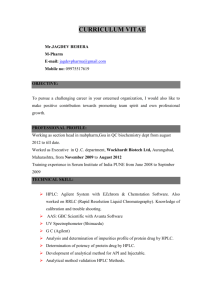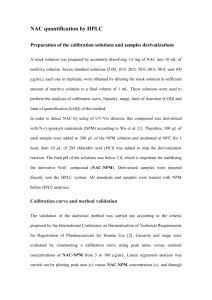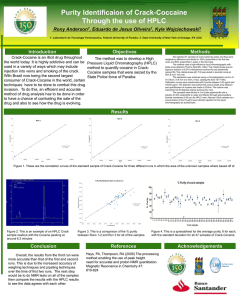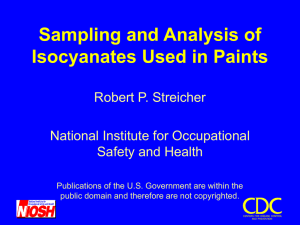WLTP-SG-Drafting-03-10e-AP sampling…
advertisement
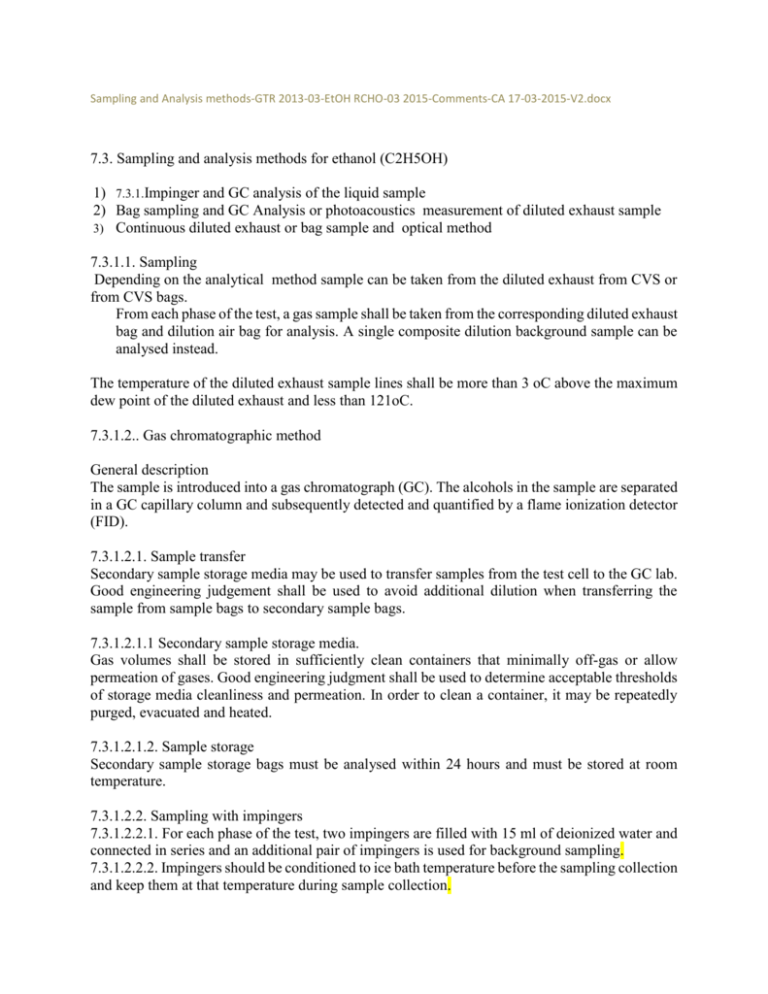
Sampling and Analysis methods-GTR 2013-03-EtOH RCHO-03 2015-Comments-CA 17-03-2015-V2.docx 7.3. Sampling and analysis methods for ethanol (C2H5OH) 1) 7.3.1.Impinger and GC analysis of the liquid sample 2) Bag sampling and GC Analysis or photoacoustics measurement of diluted exhaust sample 3) Continuous diluted exhaust or bag sample and optical method 7.3.1.1. Sampling Depending on the analytical method sample can be taken from the diluted exhaust from CVS or from CVS bags. From each phase of the test, a gas sample shall be taken from the corresponding diluted exhaust bag and dilution air bag for analysis. A single composite dilution background sample can be analysed instead. The temperature of the diluted exhaust sample lines shall be more than 3 oC above the maximum dew point of the diluted exhaust and less than 121oC. 7.3.1.2.. Gas chromatographic method General description The sample is introduced into a gas chromatograph (GC). The alcohols in the sample are separated in a GC capillary column and subsequently detected and quantified by a flame ionization detector (FID). 7.3.1.2.1. Sample transfer Secondary sample storage media may be used to transfer samples from the test cell to the GC lab. Good engineering judgement shall be used to avoid additional dilution when transferring the sample from sample bags to secondary sample bags. 7.3.1.2.1.1 Secondary sample storage media. Gas volumes shall be stored in sufficiently clean containers that minimally off-gas or allow permeation of gases. Good engineering judgment shall be used to determine acceptable thresholds of storage media cleanliness and permeation. In order to clean a container, it may be repeatedly purged, evacuated and heated. 7.3.1.2.1.2. Sample storage Secondary sample storage bags must be analysed within 24 hours and must be stored at room temperature. 7.3.1.2.2. Sampling with impingers 7.3.1.2.2.1. For each phase of the test, two impingers are filled with 15 ml of deionized water and connected in series and an additional pair of impingers is used for background sampling. 7.3.1.2.2.2. Impingers should be conditioned to ice bath temperature before the sampling collection and keep them at that temperature during sample collection. 7.3.1.2.2.3. After sampling, the solution contained in each impinger is transferred to a vial and sealed for storage and/ or transport before the analysis in the laboratory. 7.3.1.2.2.4. Samples shall be refrigerated at a temperature below 5 °C if immediate analysis is not feasible samples must be analysed within 6 days. 7.3.1.2.2.5. Good engineering practice shall be used for sample volume and handling. 7.3.1.3. Instrumentation and apparatus 7.3.1.3.1. The sample may be injected directly into the GC or an appropriate preconcentrator may be used. In case of preconcentration, this must be used for all necessary verifications and quality checks. 7.3.1.3.2. A GC-column with an appropriate stationary phase of suitable length to achieve adequate resolution of the C2H5OH peak shall be used for analysis. The column temperature profile and carrier gas selection shall be taken into consideration when setting up the method selected to achieve adequate C2H5OH peak resolution. The operator must aim for baseline separated peaks. 7.3.1.3.3. Good engineering judgment shall be used to zero the instrument and to correct for drift. An example of good engineering judgement is described in §7.2.1.3.5. 7.3.1.4. Reagents and materials Carrier gases: - Nitrogen shall have a minimum purity of 99.998 percent. - Helium shall have a minimum purity of 99.995 percent. - Hydrogen shall have a minimum purity of 99.995 percent. In case of sampling with impingers: - Liquid standards of C2H5OH in pure water. -C2H5OH 100%, analysis grade 7.3.1.5. Peak integration procedure The peak integration procedure shall be performed as in §7.2.1.5. 7.3.1.6. Linearity A multipoint calibration to confirm instrument linearity shall be performed according to §7.2.1.6. 7.3.1.7. Quality control 7.3.1.7.1. A nitrogen or air blank run shall be performed before running the calibration standard. The ethanol concentration from the blank analysis must be below the LoD before the analysis may proceed. A weekly blank run will provide a check on contamination of the complete system. 7.3.1.7.2. The calibration standard shall be analysed each day of analysis to generate the response factors used to quantify the sample concentrations. 7.3.1.7.3. A quality control standard shall be analysed within 24 hours before the analysis of the samples. 7.3.1.9. Calculations for GC 1/ from impingers and 2/diluted gas CVS 7.3.1.10. Limit of detection, limit of quantification The limits of detection and of quantification shall be determined as in §7.2.1.9. 7.3.1.11. Interference verification Interference and reducing interference error is described in §7.2.1.10. 7.4. SAMPLING AND ANALYSIS METHODS FOR FORMALDEHYDE AND ACETALDEHYDE 7.4. Sampling and analysis for formaldehyde and acetaldehyde 1) Impinger or DNPH cartridges and HPLC analysis of the liquid sample 2) Continuous diluted exhaust or bag sample and optical method 7 4.1. Sampling Depending on the analytical method sample can be taken from the diluted exhaust from CVS or from CVS bags. From each phase of the test, a gas sample shall be taken from the corresponding diluted exhaust bag and dilution air bag for analysis. A single composite dilution background sample can be analysed instead. The temperature of the diluted exhaust sample lines shall be more than 3 oC above the maximum dew point of the diluted exhaust and less than 121oC. 7.4.x. High performance liquid chromatography (HPLC) 7.4x.1. General description Aldehydes are sampled with DNPH-impregnated cartridges. DNPH (2,4-dinitrophenylhydrazine) carbonyls chemically react into their diphenylhydrazone derivatives. Elution of the cartridges is done with acetonitrile. Analysis is carried out by high performance liquid chromatography (HPLC) with ultraviolet (UV) detector at 360 nm or diodearray detector (DAD). Carbonyl masses ranging between 0.02 to 200 µg are measured by this method. 7.4.1.2.1. Sampling by cartridges 7.4.1.2.1.1. DNPH-impregnated cartridges shall be sealed and refrigerated at a temperature less than 4°C upon receipt from manufacturer until ready for use. 7.4.1.2.1.2. 7.4.1.2.1.3. The formaldehyde and acetaldehyde sampling system shall be of sufficient capacity so as to collect samples of adequate size for analysis without significant impact on the volume of the diluted exhaust passing through the CVS. 7.4.1.2.1.4. Good engineering practice shall be used to avoid sample breakthrough. 7.4.1.2.2. Sample storage If samples are not analysed the same day as received, they must be refrigerated at a temperature below 4°C. Refrigerated samples are stable for up to 30 days. 7.4.1.2.3. Sample preparation Elute the cartridges by removing their caps, extract with acetonitrile and run the extract into glass storage bottles. Transfer the solution from each cartridge to glass vials and seal with new septum screw caps. 7.4.1.3. Instrumentation - Liquid autosampler - HPLC-UV or HPLC-DAD 7.4.1.4. Reagents Reagents shall be: (a) Acetonitrile, HPLC grade (b) Water, HPLC grade (c) 2,4 DNPH, purified; unpurified DNPH must be recrystallized twice from acetonitrile. The recrystallized DNPH is checked for contaminants by injecting a diluted solution of DNPH in contaminant free acetonitrile into the HPLC. (d) Carbonyl/2,4-dinitrophenylhydrazone complexes may be purchased or prepared in the laboratory. In-house standards must be recrystallized at least three times from 95 percent ethanol. (e) Sulfuric acid, or perchloric acid, analytical reagent grade (f) DNPH-impregnated cartridges 7.4.1.4.1. Stock solution and calibration standard 7.4.1.4.1.1. A stock calibration standard is prepared by diluting the target carbonyl/2,4-DNPH complexes with acetonitrile. A typical stock calibration standard contains 3.0 µg/mL of each target carbonyl compound. 7.4.1.4.1.2. Stock calibration standards of other concentrations may also be used. 7.4.1.4.1.3. A calibration standard is prepared when required by diluting the stock calibration solution, making sure that the highest concentration of the standard is above the expected test level. 7.4.1.4.2. Control standard A quality control standard, containing all target carbonyls/2,4 DNPH complexes within the typical concentration range of real samples is analysed to monitor the precision of the analysis of each target carbonyl. 7.4.1.4.2.1. The control standard may be purchased, prepared in the laboratory from a stock solution different from the calibration standard, or prepared by batch mixing old samples, spiking it with a stock solution of target compounds, and stirring for a minimum of 2 hours. If necessary, the solution is filtered using filter paper to remove precipitation. All target compounds except acrolein have been found to be stable in the control standard. 7.4.1.5. Procedure 7.4.1.5.1. Vials containing the field blank, calibration standard, control standard, and samples for subsequent injection into the HPLC shall be prepared. 7.4.1.5.2. Columns, temperatures and solvent/eluents shall be chosen to achieve adequate peak resolution. Columns of suitable polarity and length shall be used. The method shall specify column, temperature, detector, sample volume, solvents and flow. 7.4.1.5.3. Good analytical judgment shall be used to evaluate the quality of the performance of the instrument and all elements of the protocol to provide a robust method of analysis. 7.4.1.6. Linearity A multipoint calibration to confirm instrument linearity shall be performed according to §7.2.1.6. 7.4.1.7. Quality control 7.4.1.7.1. Field blank One cartridge shall be analysed as a field blank for each emission test. If the field blank shows a peak greater than the limit of detection (LOD) in the region of interest, the source of the contamination must be investigated and remedied. 7.4.1.7.2. Calibration run The calibration standard shall be analysed each analysis day to generate the response factors used to quantify the sample concentrations. 7.4.1.7.3. Control standard A quality control standard shall be analysed at least once per 7 days. 7.4.1.8. 7.4.1.9. Limit of detection, limit of quantification The LoD for the target analytes must be determined for: (a) new instruments, (b) after making instrument modifications which can affect the LoD, and (c) at least once per year. 7.4.1.9.1. To perform the calculations, it is necessary to perform a multipoint calibration consisting of at least four “low” concentration levels, each above the LoD, with at least five replicate determinations of the lowest concentration standard. 7.4.1.9.1.2. The maximum allowable LoD of the hydrazine derivative is 0.0075 µg/mL. 7.4.1.9.1.3. The calculated laboratory LoD must be equal to or lower than the maximum allowable LoD. 7.4.1.9.1.4. All peaks identified as target compounds that are equal to or exceed the maximum allowable LoD must be reported. 7.4.1.9.1.5. For the purpose of calculating the total mass of all species, the concentrations of the compounds below the LoD are considered to be zero. . Carbonyl mass emission calculation per test phase Final mass calculation should be referred to Annex 7 paragraph 3.2.1( 7.4.1.10. Interference verification To reduce interference error, proof of chemical identity may require periodic confirmations using an alternate method and/or instrumentation, e.g., alternative HPLC columns or mobile phase compositions

